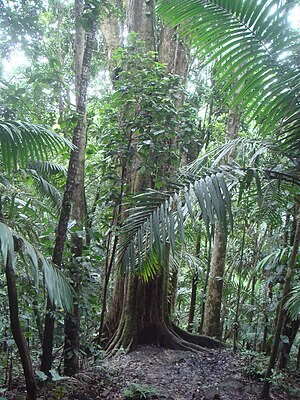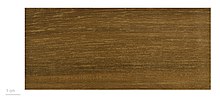Balata tree
| Balata tree | ||||||||||||
|---|---|---|---|---|---|---|---|---|---|---|---|---|

Balata tree ( Manilkara bidentata ) |
||||||||||||
| Systematics | ||||||||||||
|
||||||||||||
| Scientific name | ||||||||||||
| Manilkara bidentata | ||||||||||||
| ( A.DC. ) A.Chev. |
The balata tree ( Manilkara bidentata ) is a species of plant from the family of the sapotaceae . It is widespread in the Caribbean islands and in tropical central and northern South America.
description
The Balata tree is a slow-growing, evergreen tree that can grow to heights of more than 30 meters and a trunk diameter of 1.3 meters in the best locations. Mature trees form a dense treetop with horizontal branches. Older trees have broad buttress roots . The plant parts contain a white milky sap .
The alternate and entire, leathery leaves are elliptical to obovate with a length of up to 25 centimeters. The nerve is pinnate with many indistinct parallel lateral nerves. The leaves are bronze-colored underneath, the tip is rounded to pointed and sometimes slightly indented.
The flowering time is at the beginning of the rainy season. The stalked, hermaphroditic, radial symmetry and six-fold flowers with a double flower envelope are greenish-yellow to white. They appear in mostly axially oriented groups, terminally on the branches. The usually six-fold chalice is arranged in two circles. The six, usually three-part petals with two petaloid appendages are cream-colored, white, the corolla tube is only short. There are six antipetal stamens and six short staminodes that are fused together to form a ring at the base. The six- to achtkammerige ovary is upper constant with a long cone-shaped stylus with a small capitate scar .
The smooth, spherical and orange berries with a diameter of up to 2.5 cm have an edible, sweet pulp that usually surrounds the only one, sometimes two, and smooth, egg-shaped and flattened, dark brown seeds with a distinct hilum . On the fruit, there is often the durable stylus residue at the tip and the durable calyx at the base.
use
The wood of the Balata tree is traded under the names Massaranduba , Balata rouge, Beefwood etc. It is a tropical type of hardwood , similar to Bangkirai .
The color of the wood is a very dark red to reddish brown. With a weight of 1100 to 1300 kg / m 3, this ironwood does not float . It is used for carpentry, construction joinery, railroad ties, hydraulic engineering, bridge building, shipbuilding, furniture, veneer, musical instruments, tools, and sports equipment. In Europe, due to its weather resistance, products for outdoor use as massaranduba are particularly on the market. A negative property of this wood is the increased swelling and shrinking behavior . The wood is therefore not suitable for dimensionally stable components.
Other trade names: Maçaranduba (BR), Baiata (SR, CO), Nisperillo (CO), Quinilla (PE), Purguo morado (VE), bulletwood, beefwood (GB).
Due to its origin and the associated, mostly difficult to control “production”, the use of this tropical wood is not without controversy. Because of its slow growth, it is questionable whether sustainable and ecological forestry use is possible.
The milky sap of the balata tree, the balata , is gutta-percha-like and is used to manufacture drive belts and conveyor belts. In the past it was also often used for golf balls. Chicle , a mass of chewing gum, can also be obtained from this type .
Systematics
This species was first described in 1844 under the name Mimusops bidentata by Alphonse Pyrame de Candolle in Prodromus Systematis Naturalis Regni Vegetabilis , 8, pp. 204-205. Auguste Jean Baptiste Chevalier published the name Manilkara bidentata, which is valid today, in 1932 in Revue de Botanique Appliquée et d'Agriculture Tropicale 12 (128), p. 270.
Other synonyms for Manilkara bidentata (A.DC.) A.Chev. are: Achras balata Aubl. , Manilkara balata (Aubl.) Dubard , Manilkara balata var. Cruegeri (Pierre) Dubard , Manilkara balata var. Gutta (Pierre) Dubard , Manilkara balata var. Hartii (Pierre) Dubard , Manilkara balata var. Melinonis (Pierre) Dubard , Manilkara balata var. schomburgkii (Pierre) Dubard , Manilkara balata var. sieberi (A.DC.) Dubard , Manilkara bidentata var. cruegeri (Pierre) Chev. , Manilkara darienensis (Pittier) Standl. , Mimusops balata (Aubl.) CFGaertn. , Mimusops balata var. Cruegeri Pierre , Mimusops balata var. Gutta Pierre , Mimusops balata var. Hartii Pierre , Mimusops balata var. Melinonis Pierre , Mimusops balata var. Schomburgkii Pierre , Mimusops balata var. Sieberi (A.DC.) Pierre , Mimusops darienensis Pittier , Mimusops surinamensis Miq. , Sapota mulleri flower ex Bleekrod .
There are two subspecies:
- Manilkara bidentata subsp. bidentata : It occurs from Panama to tropical South America and the Lesser Antilles.
- Manilkara bidentata subsp. surinamensis (Miq.) TDPenn. ; it differs in the hairy flower stalks, sepals and ovaries. It occurs from the Caribbean to tropical South America.
literature
- PL Weaver: Manilkara bidentata (A. DC.) Chev. - Ausubo, Balata at Silvics of North America , Volume 2 - Hardwoods . (Section Description, Distribution and Use)
- Leaflet series Holzarten Massaranduba ( Memento from November 15, 2016 in the Internet Archive ) (PDF; 2.29 MB).
- CS Sargent : The Silva of North America. Vol. 5, Hougthon, Mifflin, 1893, pp. 181 f, t. 251, online at biodiversitylibrary.org, accessed October 21, 2018.
- James Cullen, Sabina G. Knees, H. Suzanne Cubey: The European Garden Flora. Vol. IV, Second Edition, Cambridge University Press, 2011, ISBN 978-0-521-76160-4 , p. 430.
Web links
- Manilkara bidentata at Useful Tropical Plants, accessed October 21, 2018.
- Information from DELTA commercial timbers .
- Massaranduba on holzvomfach.de.
Individual evidence
- ↑ a b c Rafaël Govaerts (Ed.): Manilkara bidentata. In: World Checklist of Selected Plant Families (WCSP) - The Board of Trustees of the Royal Botanic Gardens, Kew . Retrieved June 4, 2020.
- ↑ Manilkara bidentata at Tropicos.org. Missouri Botanical Garden, St. Louis
- ^ Terence D. Pennington: Sapotaceae. In: Fl. Neotrope. Monogr. 52, 1990, pp. 1-770, JSTOR i400231 , ISBN 978-0-89327-344-6 .
